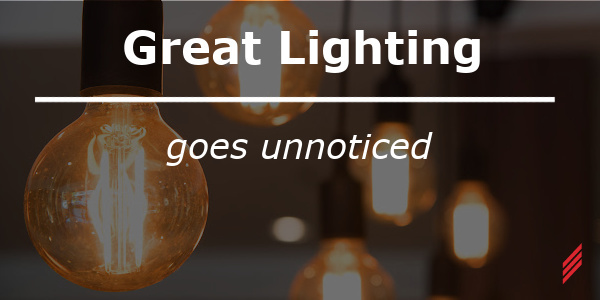Great Lighting Goes Unnoticed
by Shawn Costa on Aug 7, 2025 10:30:00 AM

Learn lighting design tips to meet IES, IECC standards with foot-candles, CRI, and daylight harvesting for energy-efficient spaces.
Ordinarily people do not pay much attention to the lighting in a space. This is especially true if a space’s lighting is designed properly. For the exception of some modern-styled pendant lighting, or eloquent wall sconces, lighting only gets a mention if a given area is too dark, or even too bright. This is unfortunate, especially if one understands all the factors that play a role in the final layout and light levels in a space.
Are You Bright Enough?
The Illuminating Engineering Society (IES) recommends average light levels in different space types to ensure adequate illumination for a space’s given task and for safety of the occupants. Light is measured in foot-candles (fc), with one foot-candle equaling one candela at a distance of one foot away, or one lumen (the amount of light emitted per second) per square foot.
Shedding Light on Light Fixtures
When selecting light fixtures for a space, it is important to choose the proper lumen output. Also, especially with LED lighting, the color temperature of the emitted light will also directly impact the delivered lumens, which is measured in degree Kelvins (°K). In the discussion of interior lighting, typical Kelvin temperatures will range from 2700°K up to 4000°K. The figure below displays the perceived color throughout the scale:
While the Kelvin temperature certainly affects the overall warmth/coldness of a fixture, each individual LED within the light fixture may stray from the color it is trying to achieve. These deviations in color are gauged in MacAdam ellipses and are measured in steps (sd). For example, a one-step MacAdam ellipse represents one deviation from the target color, a two-step MacAdam ellipse represents two deviations from the target color, etc., etc. Although the American National Standards Institute (ANSI) has a tolerance of a four-step ellipse, most lighting manufactures stay within a three-step ellipse.
Another value given to a light fixtures performance is its color rendering index, or CRI for short. CRI is value given to a fixture which grades it from 0 to 100 based on how true the light output renders colors. While fluorescent lighting typically had a CRI of 70, LED lighting can typically be specified with a CRI of 80 or even 90. The image below illustrates how much 20 CRI can change the perception of color.
Putting it into Perspective
Let’s take a simple office and assume it has a lay-in ceiling with a height of 8’-6” above the floor. For the office in our example, IES recommends an average light level of 40fc (for perspective, your typical department store should have a light level of 40fc). While always trying to meet the IES requirements, the current International Energy Conservation Code (IECC) limits lighting in enclosed offices to a power density of 1.11 watts per square foot. The figure below displays the foot-candle levels throughout the space after placing (4)2x2 light fixtures in the room, with an output of 2000 lumens each and a Kelvin temperature of 3500°. The selected fixtures meet the IECC power density requirement:
The figure above not only takes into account the light emitted from the fixtures, but also the surface reflectiveness of the ceiling, floor, and walls. Typically, as in the figure above, it is assumed that the space will have a mildly reflective white ceiling, neutral walls, and a non-reflective floor. These surfaces are assigned values of 80-50-20 respectively. If the walls of the same office as in the figure above are painted with a brighter color, the foot-candle readings and perceived brightness of the office rise:
Yet another factor which may affect the overall brightness of a space is the introduction of natural daylight via a window or skylight. A carefully thought out lighting layout in a space can quickly become uncomfortable once an afternoon sun shines in. To combat this, daylight sensors can be utilized to send a signal to the light fixtures within the daylight zone to reduce the power delivered to the fixtures, thus reducing the lumen output. This process is also known as daylight harvesting. Not only does daylight harvesting help maintain a constant foot-candle level in a space, it also reduces energy consumption.
A Glaring Conclusion
Ever since 1878 when Edison greatly improved the incandescent lamp, lighting has been ever changing. From incandescent to fluorescent, and now LED, we have been striving to properly illuminate our environments using the least amount of energy possible. Every space is unique and contains its own set of obstacles. Overcoming said obstacles, while meeting IES and IECC requirements, while coordinating with other MEP disciplines can tend to be a constant juggling act from the start of a project, to its finish. But to quote Mr. Edison; “I have not failed. I've just found 10,000 ways that won't work”.
About the Author
Shawn Costa spent 10 years providing electrical designs in the healthcare sector prior to joining Hallam-ICS. Now approaching 10 years with Hallam-ICS, he is a project manager working on a variety of projects from higher education to biopharma.
Read My Hallam Story
About Hallam-ICS
Hallam-ICS is an engineering and automation company that designs MEP systems for facilities and plants, engineers control and automation solutions, and ensures safety and regulatory compliance through arc flash studies, commissioning, and validation. Our offices are located in Massachusetts, Connecticut, New York, Vermont and North Carolina Texas, Florida and our projects take us world-wide.
You May Also Like
These Related Stories

Pad Mounted Transformer Arc Flash Calculations with SKM and IEEE

How to Interpret Harmonics Data – A Case Study








No Comments Yet
Let us know what you think